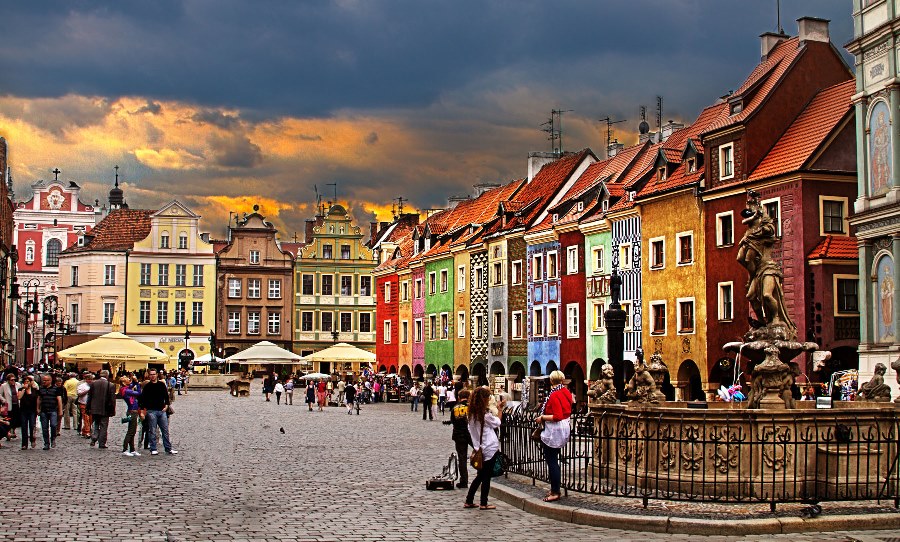Past the Midpoint
We have now completed five months of our 10-month adventure here in Poznan. Although our lives have settled into a somewhat predictable routine, we are no less thrilled at this amazing opportunity. We have accomplished a lot, as my previous 12 posts attest, but there are many things remaining on our agenda and diminishing time in which to achieve them.
The weather has been reminding us lately that the calendar says there's plenty of winter left. Temperatures have been hovering at or slightly above and below freezing for some time, with only a slight warming pattern slated for the days ahead. Cold rain and drizzle have been regular companions, and yesterday saw a sleet storm, two brief snow storms, gusty winds, blue sky and sunshine all in the course of two hours. It's easy to predict when the worst weather will hit -- it's always when I'm lugging a heavy computer bag, a couple portfolios and a camera while trying to hold on firmly to an umbrella, walking to or from the tram or class in another building and dodging traffic. On the other hand, visible now are the first green buds of spring on the shrubbery in parks and gardens. We just need to hold out a little while longer before the earth explodes in its finest spring frippery.
Teaching and Other Student Encounters
After a short break, the "summer" semester has begun, and we are already two weeks into the term, which will continue through mid-June -- hence the "summer" moniker, though the designation doesn't seem quite so apt in February in Poland. I'm teaching two classes, International Public Relations and Corporate Communication (which I am choosing to focus on internal/employee communication). Each class has around 25 students, all exchange students as was the case during the winter semester recently ended. In addition to the same European and Asian countries represented in my classes during the previous semester, I now have students from Greece, Russia, Armenia and Belarus.
I continue to seek additional opportunities to engage in the life of the university here and participated as a panel member leading a discussion on "Internationalizing Poznan" earlier this week. About 50 exchange students attended, and I was joined on the panel by three representatives of Poznan government agencies. It was a fascinating discussion on steps Poznan might consider to contribute to its growing appeal as a destination for business, tourism and academic exchange.
Also this week, I accepted an invitation to meet with a group of gifted and ambitious graduate and undergraduate business students, members of a club called "ASAP." The group augments their already demanding academic agenda by inviting guest speakers, with a focus on native English speakers, to lead discussions related to contemporary business practices. I spent 90 minutes with the group talking about the importance of building an organizational culture of trust and openness through effective internal communication structures, procedures and policies. My hope is that these future CEO's will incorporate these concepts into their business visions and approaches in the years ahead.
 |
| Meeting with "ASAP," a student-led business club. |
A Brief Roman Holiday
During the week between semesters, Robin and I squeezed in a few days in Rome. Direct flights from Poznan to many European destinations on low-cost airlines are a constant temptation, and the 2-hour flight to Rome was irresistible. Robin had been to Rome more than 30 years ago, and I have been to other parts of Italy, but this was my first visit to the historical capital. We booked a small, pleasant hotel in the Vio Veneto district, close to prime tourist attractions such as Trevi Fountain and the Spanish Steps (under repair and blocked off during our visit). In January, tourist levels are down and the weather is pleasant enough to permit comfortable walking to many attractions. While hours-long lines characterize peak tourist season, we waited in very short lines and sometimes no lines at all for sites such as the Colosseum, the Catacombs, Palatine Hill, even the Vatican, including St. Peter's Basilica and the Sistene Chapel. Restaurants and coffee shops were always available without reservations thanks to the absence of tourists. I've included a few photos below, but for an overdose of our snaps, visit this Drop Box site: Alan and Robin's Rome Pix.
More of Poznan's Cultural Scene
Earlier this week, the Academy of Music here hosted an exceptional performance of all five of Beethoven's piano concerti over two splendid evenings. With a world-class pianist and a 40-piece orchestra, the experience was mesmerizing. What an extraordinary feat for a pianist -- to perform the five concerti in succession over two evenings. As always with events at the Academy, the quality was superb. And the cost? As always, free. This is an amazing place for lovers of fine music.
 |
| The pianist and the orchestra receive well-earned appreciation from a grateful audience. |
Leaving Our Footprint
One final note -- we were graciously invited recently to the home of one of my colleagues in the department in which I'm teaching here at the Poznan University of Economics. Dr. Jacek Trebecki, with whom I have collaborated on a number of research, writing and teaching projects, invited us to dinner at a wonderful local neighborhood restaurant then to his home for tea and dessert. It was my privilege to provide Jacek, his wife, Asia, and their three great children with souvenirs of my home university. They obligingly posed for the photo below.
That's a wrap for this edition of the blog. Thank you most kindly for your visit, and I hope you'll drop in again. Do widzenia!




















